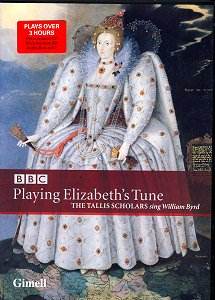A recital of the music by William Byrd, sung
by the Tallis Scholars under Peter Phillips; what more could you
want? Using a choir of around twelve voices, (the exact number
varies according to the piece), with female sopranos sounding
both pure and expressive, male altos and the familiar Tallis Scholars’
care and attention to line and shape, Peter Phillips and his group
deliver an immensely rewarding recital. But then someone decided
to go and make a DVD not a CD.
This raises all sorts of issues about what visuals
can bring to such a recital, and unfortunately this disc solves
none of these. The Tallis Scholars stand in a concert formation
arc in the choir of Tewkesbury Abbey for the entire recital. There
is no audience, so it would have been welcome if they had tried
using the choir stalls; after all this is religious music. The
choir are frankly visually uninspiring and poorly styled. This
is something that the English musical establishment have not learned
from the French. The performances of Les Arts Florissants are
not only musically stunning but beautifully styled visually. And
would it have been too much to ask for the Tallis Scholars to
have sung without the visually distracting scores.
The performance is billed as being by candle-light,
but initially the choir are back-lit with a strange blue glow.
This changes to yellow/orange, which is less distracting, then
finally for the Mass for four voices which concludes the recital,
we have just plain candle-light. Even Tewkesbury Abbey is not
used to its utmost, as initially the camera never strays beyond
the choir. Instead it restlessly roams round giving us individual
shots and general shots of the whole group; never resting long
enough in one place for us to develop a proper relationship with
the choir.
The advantages of DVD are limited on this disc
as well. There are subtitles, but they appear at the beginning
of each section of a piece and then frustratingly disappear. The
running order is different to that printed on the box and there
are no printed notes so you have no way of learning about a piece
whilst it is playing.
Musically this disc is superb, but frankly I
would be just as happy with a CD. The choir give us a fine performance,
each lovely line perfectly focused and shaped. But some of these
pieces are now understood to be messages of support to the Catholic
recusants, so should it sound so simply beautiful?
In addition to the recital there is a documentary
about Byrd’s life, presented by Charles Hazelwood. This
consists of performances of Byrd’s works alternating with
talking heads and sections of continuity from Hazelwood. This
works pretty well for Byrd as there is really so much about him
that we don’t know. The programme does well at giving the
background to the problems of life as a Catholic in Protestant
England and manages to cover such illuminating and varied issues
as Byrd’s litigiousness and the difficulty of accurately
defining what forces actually sang the Gradualia. This documentary
re-uses (sometimes bodily) the music from the recital, so that
though it does help with the background to the pieces we manage
to hear them twice, which perhaps makes us feel short-changed.
Finally, the disc includes an audio bonus of
performances of the Mass for 5 voices, Mass for 3 voices and the
motet Tribue Domine taken from the choir’s CDs. After the
restless and unhelpful visuals of the main recital, it was a blessed
relief to sit back and simply listen to the choir’s glorious
performances.
Robert Hugill


